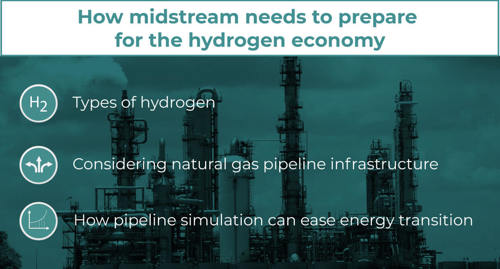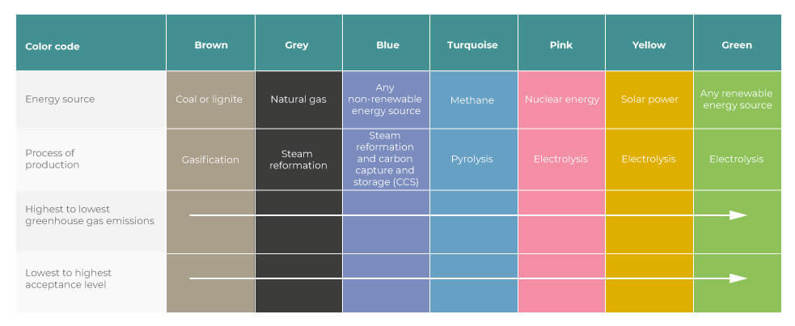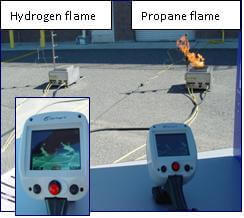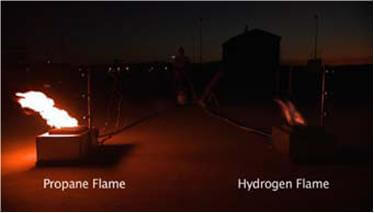Hydrogen: Vital for energy transition?
Ambitious targets have been set to help slow climate change, with organizations agreeing at last year’s COP26 to align with meeting net zero emissions by the middle of the century1. Decarbonization is at the top of agendas and a lot of the focus is on energy transition and carbon capture and storage (CCS).
New ways to produce energy are being explored and hydrogen (H2) is one of the key areas gaining momentum. Pure hydrogen is obtained by splitting molecules, either through steam reforming or electrolysis2. Once produced, H2 can either be burnt directly or mixed with oxygen to create a fuel cell, which is like a battery, with the only waste being water (H2O). With a 28% growth in the demand for hydrogen in the last decade its popularity is increasing, partly due to the fact it has an exceptional energy density (MJ/kg)3.
But is the energy industry ready for this highly discussed transition? In this article we’ll explore how midstream would need to prepare for hydrogen.
- Types of hydrogen
- Considering natural gas pipeline infrastructure
- How pipeline simulation can ease energy transition

Types of hydrogen
Hydrogen is an invisible gas. Different color descriptions are used for it, to help distinguish different production methods. So far there’s black or brown, grey, blue, turquoise, pink, yellow, green and white hydrogen.
White hydrogen is naturally occurring, found in underground deposits and created through fracking. There are no strategies to exploit this hydrogen currently4.

Figure 1: Different types of hydrogen and their production methods
Currently, around 95% of all hydrogen is produced from steam reforming of natural gas5. The main issue with black or brown and grey hydrogen is that they still emit a large amount of greenhouse gasses and there’s no CCS as part of the process to reduce this. Black or brown hydrogen use fossil fuels as part of their production process. Black coal or lignite (brown coal) is used, with carbon dioxide (CO2) and carbon monoxide (CO) being emitted.
Blue hydrogen on the other hand is sometimes referred to as being carbon neutral. Most of the emissions captured through CCS are not dispersed into the atmosphere, despite the fact the process may use fossil fuels as an energy source. There are arguments that it should be labelled as “low carbon”, as a more accurate description since 10 to 20% of the generated carbon cannot be captured6.
Turquoise hydrogen is relatively new. It sits between blue and green hydrogen and uses methane pyrolysis as a production method. The outputs of this process are the hydrogen and carbon, however unlike steam reformation the carbon is solid7. This means there’s no requirement for CCS, the solid carbon can be used in other applications such as a soil improver or the manufacturing of goods like tires.
Nuclear produced hydrogen, often referred to as pink (or sometimes purple or red) is generated through electrolysis. The very high temperatures from nuclear reactors could also be used in other hydrogen productions by producing steam for more efficient electrolysis or fossil gas-based steam methane reforming4.
Hydrogen that is produced using renewable energy sources is green or yellow. Yellow hydrogen is a relatively new phrase for hydrogen made through electrolysis using solar power. Green H2 can be produced by any renewable energy source.
Considering natural gas pipeline infrastructure
There’s a lot of talk about repurposing natural gas pipelines for hydrogen as part of a circular economy. But there are some key concerns about this idea. Hydrogen embrittlement is when the metal degrades. The stress that this puts the pipeline under means that it’s likely to rupture or leak.
One report found that hydrogen gas was capable of dissociating (separation of the atoms) into protons, resulting in the pipeline absorbing them into its surface8. Defects such as fresh dislocations or cracks near the internal surface of the pipeline were culprits for this disassociation. Therefore, it is essential that the infrastructure has little to no defects to transport H2. The report also found that steel composition analysis would need to be refined beyond what is current practice, looking further into the microstructure of the steel. Limiting analysis to the hardness of the steel is not enough to reduce the risk of embrittlement8. There’s also a concern that hydrogen can permeate metal, leaking through the pipeline. Also the chance of leakage through any defects in the pipe wall, or fittings is far greater than with natural gas. Its low density means that the atoms are challenging to contain.
Once released into the air, hydrogen becomes flammable. Since it is around 57 times lighter than gasoline vapor and 14 times lighter than air, it disperses very rapidly once in an open environment9. The flammability of H2 ranges between 4% and 75% in air, a wider range when compared with other fules9. The flame of hydrogen is almost invisible in daylight and just about visible at night, making it harder to detect by just human senses. Therefore, the automatic detection of hydrogen leakage and burning is critical.


Figure 2: Hydrogen burning during the day and at night9
The need for a reliable leak detection system
A pipeline leak detection system (LDS) is a vital consideration for the midstream to prepare for hydrogen. Pipeline operators will require a system that’s sensitive and accurate to mitigate the risks of a rupture or leak.
Solutions like Atmos Simulation (SIM) Suite can detect and locate leaks effectively. It uses the hydraulic model and statistical analysis algorithm to detect leaks reliably and locate them accurately
For areas like hydrogen where pipeline operators are relatively inexperienced, it is important to have a reliable LDS. The application of Atmos SIM helps increase the confidence of pipeline controllers who must decide on a suspected leak.
How pipeline simulation can ease energy transition
There are a lot of unknowns surrounding decarbonization initiatives such as the shift to hydrogen energy. Pipeline simulation can be a useful tool to help facilitate the transition from natural gas to hydrogen. With the discussion around using existing infrastructure, pipeline operators need to fully understand the capacity constraints.
Pipeline simulators such as Atmos SIM can be used to model hydrogen blends. When used offline, simulation can help pipeline companies understand whether network reinforcement is required.
There are three core considerations for understanding how the network will cope with future demand and how H2 will impact network capacity. They are:
- Supply locations
- Network topology
- Demand pressure requirements
To answer questions surrounding these core considerations, a base case for 100% natural gas is constructed using the current maximum daily quantity (MDQ) at all demands. The results show a total demand of 345 Tj/d (Terajoule per day).

Figure 3: A base case using maximum daily quantity (MDQ)
The MDQ is a starting point for analysis. Total demand is increased every 24 hours, divided up as per the starting state. Atmos SIM makes this task easier with demand groups. Once the minimum pressure constraint is violated, the demand is reduced to maintain pressure. The point this happens is deemed as maximum capacity.
Figure 3 demonstrates the maximum capacity is reduced as hydrogen concentration increases, calculating the capacities as:
- 100 natural gas 900 Tj/day
- 10% hydrogen 850 Tj/day
- 25% hydrogen 750 Tj/day
- 50% hydrogen 700 Tj/day

Figure 4: Hydrogen blend maximum capacity calculated by Atmos SIM (red 0%, green 10%, blue 25% and orange 50%)
Preparing midstream for hydrogen
The transition to hydrogen presents some key challenges and unknowns for pipeline operators. There are questions around how H2 will impact infrastructure, with hydrogen embrittlement a key area of concern. This means a reliable and accurate LDS will be crucial for midstream. LDS’ help to mitigate the risks that ruptures and leaks pose by detecting and locating them accurately. This means that pipeline operators can get engineers to site as quickly as possible to isolate the leak.
Pipeline simulation tools can also help by reducing areas of uncertainty. Helping pipeline operators to learn how their infrastructure will cope with different blends of hydrogen. This process is made easier and automated in Atmos SIM Offline.
Reference
1https://ukcop26.org/cop26-goals/
2https://www.youtube.com/watch?v=fkX-H24Chfw
3https://www.woodmac.com/market-insights/topics/hydrogen-guide/
4https://www.nationalgrid.com/stories/energy-explained/hydrogen-colour-spectrum
5https://www.energy.gov/eere/fuelcells/hydrogen-fuel-basics
6https://www.weforum.org/agenda/2021/07/clean-energy-green-hydrogen/
7https://fsr.eui.eu/between-green-and-blue-a-debate-on-turquoise-hydrogen/
8https://www.advisian.com/en/global-perspectives/in-the-pipeline--an-analysis-of-hydrogen-embrittlement-in-australias-pipeline-networks
9https://h2tools.org/bestpractices/hydrogen-compared-other-fuels
